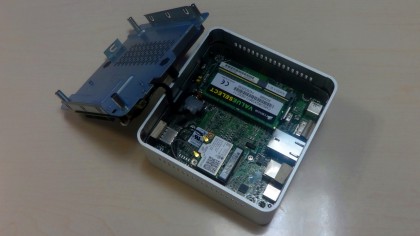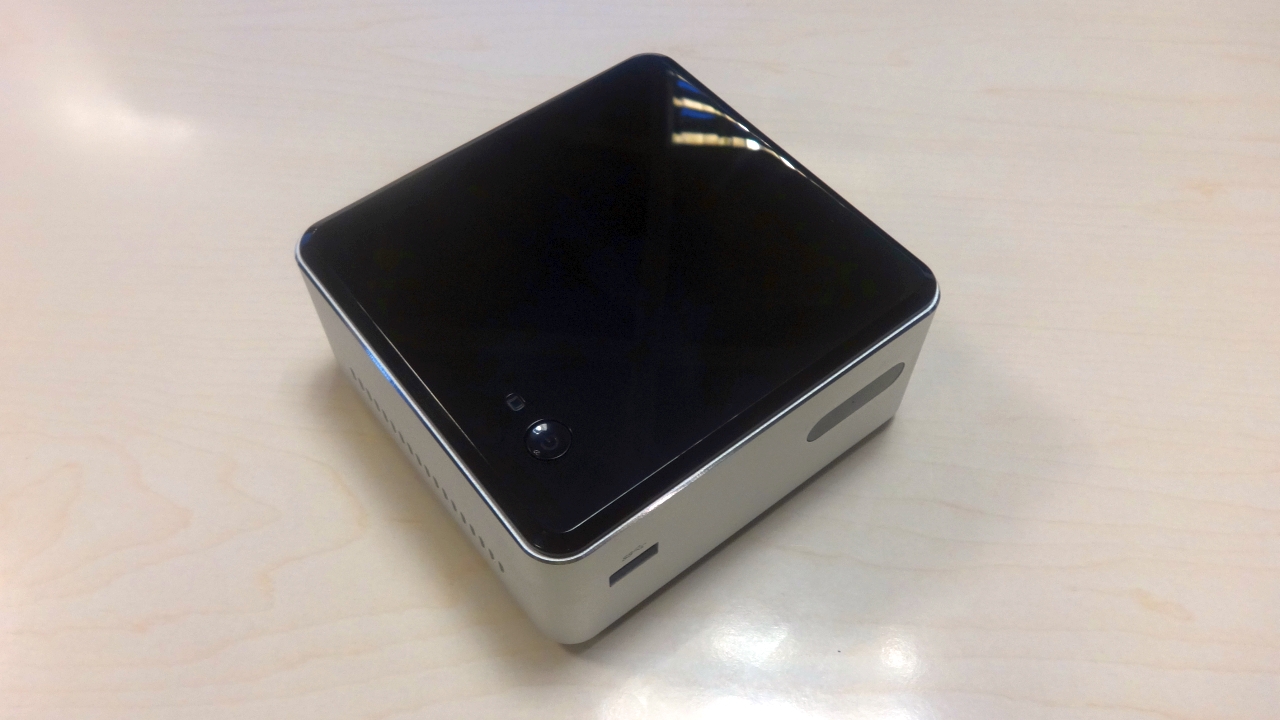Why you can trust TechRadar
For the purpose of this review, the DN2820FYKH ran on a single 8GB Corsair Value memory module with a 128GB Adata SSD, the Premier Pro SP600.
I installed Windows 8.1 Enterprise (64-bit) using a USB drive and proceeded to get the latest drivers and a BIOS update, all of which date from as late as August 2014.
Opening the device is a task accomplished in minutes. You won't be able to remove the tiny motherboard and the rest of the components unless you use some brute force.

Despite its name, the Intel Celeron N2820 that powers the DN2820FYKH has its roots firmly in the Atom architecture. This Bay Trail product was launched late last year with two cores running at 2.13GHz. It is a 64-bit model and is etched using a 22nm process. It does offer virtualisation and a number of Intel's so-called advanced technologies (Enhanced SpeedStep, Smart Connect, Execute Disable Bit).
Specifications
- CPU: Intel Celeron processor N2820 clocked at up to 2.4GHz
- Graphics: Intel HD Graphics
- RAM: supports up to 8GB DDR3L
- Storage: supports a 2.5-inch SATA drive.
- Ports & connectivity: 3 USB ports (one USB 3.0), GbE port, HDMI, audio, IR receiver, Wireless-N, Bluetooth 4.0, WiDi
Performance
To put it bluntly, this computer won't set your world alight. Use it for light tasks and you will be a happy user. Beyond web browsing and office applications, the Intel NUC will struggle. A lot.
The benchmarks show it clearly, this is not a computer for gamers or creative people, even when loaded with plenty of RAM and a speedy SSD. All of the tests were carried out at a resolution of 1280 x 1024 and the CPU/GPU combination is the obvious weakness.
- 3DMark: Fire Strike: 0; Cloud Gate: 1074; Ice Storm: 13313
- PCMark 8: 1175 (home); 1656 (work); 833 (creative)
- Cinebench: CPU: 65cb; graphics: 5.66fps
Verdict
Who will buy an NUC? Someone who doesn't mind tinkering with a PC, or someone who wants something small enough to be tucked away and left to run 24x7, 365. On top of that, it has a built-in IR receiver and looks gorgeous
However, if you're looking for a complete computer, then costs start to escalate very quickly, especially if you want a full version of Windows. Add in the system memory, the SSD, a monitor, keyboard and mouse and you're hitting £300 (about US$500, AU$530) before you know it.
The real competition doesn't actually come from computers (or even laptops) but from tablets. Take the Acer Iconia W4 for example. It is fully configured 8-inch tablet and costs only £180 (about $290, AU$310)
The extra money paid gets you a display, a card reader, a quad-core processor, an integrated battery, two cameras, Windows 8.1 and Office 2013 as well as system memory (2GB) and onboard storage (32GB). And the worst is to come with prices set to fall down even more by the year's end.
We liked
Its affordable price, finish, design and size are what make the DN2820 so attractive. Compared to "netboxes" from the previous years, it packs a much smaller power supply unit and the bundled IR receiver makes it great for those who want to transform it into a capable Home Theatre PC.
We disliked
Being so small means that its expansion capability is near zero. While being excellent as a thin client, the DN2820 simply isn't powerful enough for demanding computer tasks. Both its CPU and GPU need a significant boost in order to make it a worthy candidate for a full desktop replacement. But then, one might argue that you would have to fork out more to get something more powerful.
Final verdict
If you don't mind the glaring downsides and focus instead on other features like design and price, then Intel's most affordable NUC looks like a bargain. Otherwise, be prepared to spend a lot more if you want to stick to the same form factor.

Désiré has been musing and writing about technology during a career spanning four decades. He dabbled in website builders and web hosting when DHTML and frames were in vogue and started narrating about the impact of technology on society just before the start of the Y2K hysteria at the turn of the last millennium.
